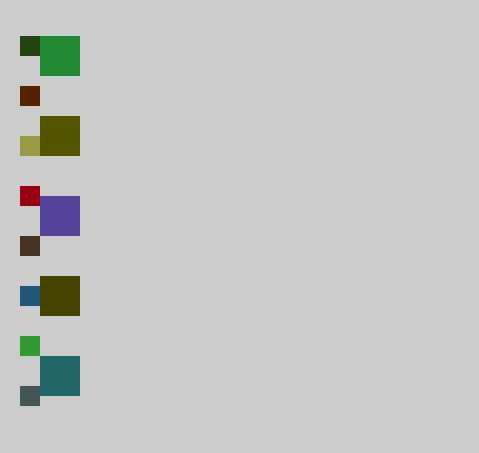我相信,当你读完这篇100%原创文章时,javascript 面向对象和继承轻松拿下不再是问题。
统一的html和css
<div id="app"></div>
#app{
position: relative;
width:500px;
height:500px;
background: #ccc;
}
第一,面向对象是什么,为什么需要它。
这里有另外一个词,叫面向过程。先理解这个,比如我们需要用js写出一个div自由降落的效果。我们自然而然是手动创建一个div,并且赋予它大小颜色位置做出运动。ok,这个问题不大,相信每个人都能搞定。
var app = document.getElementById(‘app‘);
var div = document.createElement(‘div‘);
var count = 0;
div.style.position = ‘absolute‘;
div.style.width = 20 + ‘px‘;
div.style.height = 20 + ‘px‘;
div.style.background = getColor();
app.appendChild(div);
requestAnimationFrame(rectMove)
function rectMove() {
requestAnimationFrame(rectMove)
div.style.top = (count++) + ‘px‘;
if(div.offsetTop>480){
app.removeChild(div)
}
}
function getColor(){
return ‘#‘+Math.floor(Math.random()*10)+Math.floor(Math.random()*10)+Math.floor(Math.random()*10);
}
然而,第二天产品说要源源不断的div(不同颜色,大小相同)自由降落,这时,我们脑袋就大了,难道要for循环几千上万个div?貌似不妥啊,小的做不到啊。。这就是面向过程的写法和弊端。
这时候就需要面向对象的方法了。也就是用一个function,生成源源不断的对象,这些对象大部分属性方法都相同(比如大小相同),个别属性方法特殊(比如颜色不同)。
var app = document.getElementById(‘app‘);
var rects = [];
var count = 0;
function Rect1(width,height,x,backColor){
this.speed = -1;
this.x = x;
this.width = width;
this.height = height;
this.backColor = backColor;
}
Rect1.prototype.move = function(){
this.nodeName.style.top = (this.nodeName.offsetTop - this.speed) + ‘px‘;
};
function addChild(obj){
var ele = document.createElement(‘div‘);
ele.style.position = ‘absolute‘;
ele.style.x = obj.x + ‘px‘;
ele.style.width = obj.width + ‘px‘;
ele.style.height = obj.height + ‘px‘;
ele.style.background = obj.backColor;
app.appendChild(ele);
obj.nodeName = ele; //这个要注意
}
requestAnimationFrame(rectMove)
function rectMove() {
requestAnimationFrame(rectMove)
count++;
if (count % 50 == 0) {
var rect = new Rect1(20, 20,20, getColor());
addChild(rect);
rects.push(rect)
}
for (var i = 0; i < rects.length; i++) {
rects[i].move();
if (rects[i].nodeName.offsetTop > 480) {
app.removeChild(rects[i].nodeName);
rects.slice(item, 1)
}
}
}
function getColor(){
return ‘#‘+Math.floor(Math.random()*10)+Math.floor(Math.random()*10)+Math.floor(Math.random()*10);
}

效果不错吧,美滋滋,详细细节请看阮大神这一章封装。结论就是,面向对象最优的方法是把方法定义在prototype对象上,属性写在构造函数上。
但是,第三天,亲的产品又来了,说要再加一列div自由的降落。有了面向对象的我们,问题不大的,手起刀落写下下面的代码。
var app = document.getElementById(‘app‘);
var rects = [];
var rects2 = [];
var count = 0;
function Rect1(width,height,x,backColor){
this.speed = -1;
this.x = x;
this.width = width;
this.height = height;
this.backColor = backColor;
}
Rect1.prototype.move = function(){
this.nodeName.style.top = (this.nodeName.offsetTop - this.speed) + ‘px‘;
};
//----- 新增重复的内容,第二列
function Rect2(width,height,x,backColor){
this.speed = -1;
this.x = x;
this.width = width;
this.height = height;
this.backColor = backColor;
}
Rect2.prototype.move = function(){
this.nodeName.style.top = (this.nodeName.offsetTop - this.speed) + ‘px‘;
};
//----- 新增重复的内容
function addChild(obj){
var ele = document.createElement(‘div‘);
ele.style.position = ‘absolute‘;
ele.style.width = obj.width + ‘px‘;
ele.style.height = obj.height + ‘px‘;
ele.style.left = obj.x + ‘px‘;
ele.style.background = obj.backColor;
app.appendChild(ele);
obj.nodeName = ele;
}
requestAnimationFrame(rectMove)
function rectMove(){
requestAnimationFrame(rectMove)
count++;
if(count%50==0){
var rect = new Rect1(20,20,20,getColor());
addChild(rect);
rects.push(rect)
}
rects.forEach(function(item,index,array){
item.move();
if(item.nodeName.offsetTop>480){
app.removeChild(item.nodeName);
rects.slice(item,1)
}
})
if(count%80==0){
var rect = new Rect2(40,40,40,getColor());
addChild(rect);
rects2.push(rect)
}
rects2.forEach(function(item,index,array){
item.move();
if(item.nodeName.offsetTop>480){
app.removeChild(item.nodeName);
rects.slice(item,1)
}
})
}
function getColor(){
return ‘#‘+Math.floor(Math.random()*10)+Math.floor(Math.random()*10)+Math.floor(Math.random()*10)
}

效果如上,也还能见人。但是我们担心啊,万一万恶的产品明天要第三列怎么办,把新增重复的内容再来一遍?不可能啊,这多愚蠢啊。此时,我们伟大的继承上场了啊。
var app = document.getElementById(‘app‘); var rects = []; var rects2 = []; var count = 0;
//父类构造函数和方法 function Rect(width,height,x,backColor){ this.speed = -1; this.x = x; this.width = width; this.height = height; this.backColor = backColor; } Rect.prototype.move = function(){ this.nodeName.style.top = (this.nodeName.offsetTop - this.speed) + ‘px‘; };
//增加一个extend继承函数(寄生组合继承) function extend(Parent) { var Child = function(){ return Parent.apply(this, arguments); }; var F = function() {}; F.prototype = Parent.prototype; Child.prototype = new F(); Child.prototype.constructor = Child; Child.asdasdasdasd = Parent.prototype; return Child; } var Rect1 = extend(Rect); var Rect2 = extend(Rect);
// 这里就可以继续增加各种构造函数了,然后衍生,比如第三列增加一个border-radius属性变成圆形。 function addChild(obj){ var ele = document.createElement(‘div‘); ele.style.position = ‘absolute‘; ele.style.width = obj.width + ‘px‘; ele.style.height = obj.height + ‘px‘; ele.style.left = obj.x + ‘px‘; ele.style.background = obj.backColor; app.appendChild(ele); obj.nodeName = ele; } requestAnimationFrame(rectMove) function rectMove(){ requestAnimationFrame(rectMove) count++; if(count%50==0){ var rect = new Rect1(20,20,20,getColor()); addChild(rect); rects.push(rect) } rects.forEach(function(item,index,array){ item.move(); if(item.nodeName.offsetTop>480){ app.removeChild(item.nodeName); rects.slice(item,1) } }) if(count%80==0){ var rect = new Rect2(40,40,40,getColor()); addChild(rect); rects2.push(rect) } rects2.forEach(function(item,index,array){ item.move(); if(item.nodeName.offsetTop>480){ app.removeChild(item.nodeName); rects.slice(item,1) } }) } function getColor(){ return ‘#‘+Math.floor(Math.random()*10)+Math.floor(Math.random()*10)+Math.floor(Math.random()*10) }
大家好好屡屡,
Rect,Rect1,Rect2三者的关系。一个爸爸两个儿子。
全部代码的地址 github。欢迎各位同学给右上角
 。
。
